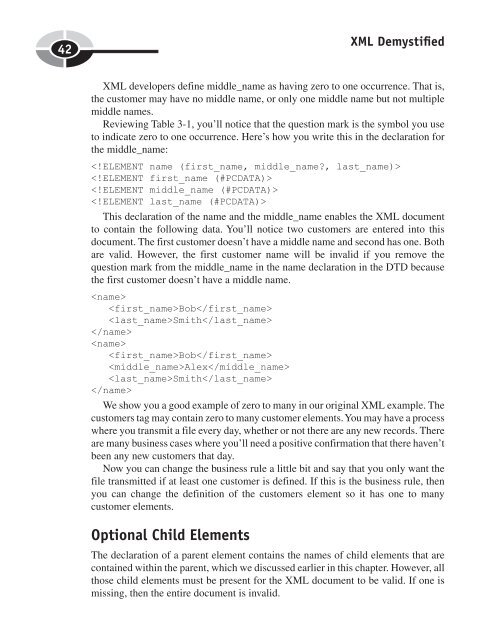You also want an ePaper? Increase the reach of your titles
YUMPU automatically turns print PDFs into web optimized ePapers that Google loves.
42<br />
<strong>XML</strong> Demystifi ed<br />
<strong>XML</strong> developers define middle_name as having zero to one occurrence. That is,<br />
the customer may have no middle name, or only one middle name but not multiple<br />
middle names.<br />
Reviewing Table 3-1, you’ll notice that the question mark is the symbol you use<br />
to indicate zero to one occurrence. Here’s how you write this in the declaration for<br />
the middle_name:<br />
<br />
<br />
<br />
<br />
This declaration of the name and the middle_name enables the <strong>XML</strong> document<br />
to contain the following data. You’ll notice two customers are entered into this<br />
document. The first customer doesn’t have a middle name and second has one. Both<br />
are valid. However, the first customer name will be invalid if you remove the<br />
question mark from the middle_name in the name declaration in the DTD because<br />
the first customer doesn’t have a middle name.<br />
<br />
Bob<br />
Smith<br />
<br />
<br />
Bob<br />
Alex<br />
Smith<br />
<br />
We show you a good example of zero to many in our original <strong>XML</strong> example. The<br />
customers tag may contain zero to many customer elements. You may have a process<br />
where you transmit a file every day, whether or not there are any new records. There<br />
are many business cases where you’ll need a positive confirmation that there haven’t<br />
been any new customers that day.<br />
Now you can change the business rule a little bit and say that you only want the<br />
file transmitted if at least one customer is defined. If this is the business rule, then<br />
you can change the definition of the customers element so it has one to many<br />
customer elements.<br />
Optional Child Elements<br />
The declaration of a parent element contains the names of child elements that are<br />
contained within the parent, which we discussed earlier in this chapter. However, all<br />
those child elements must be present for the <strong>XML</strong> document to be valid. If one is<br />
missing, then the entire document is invalid.


